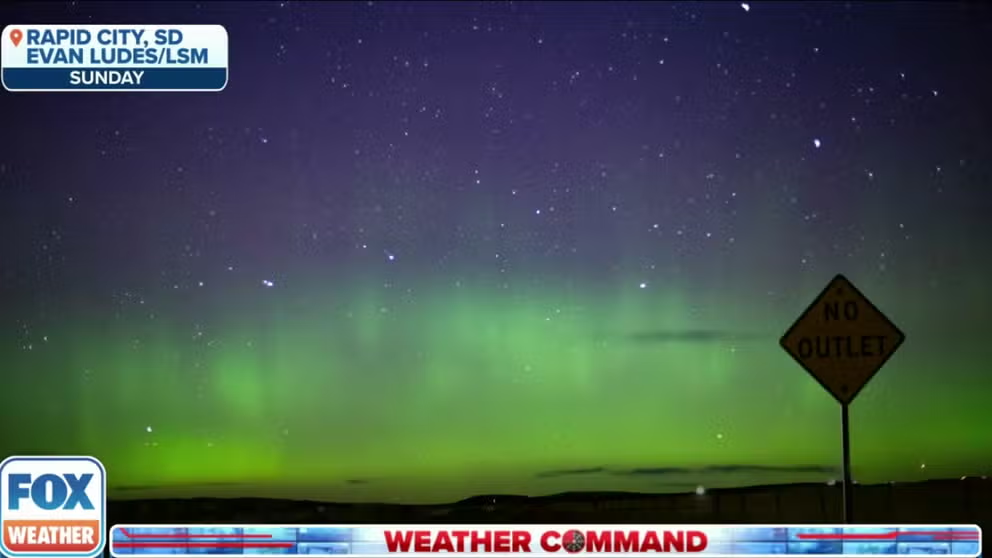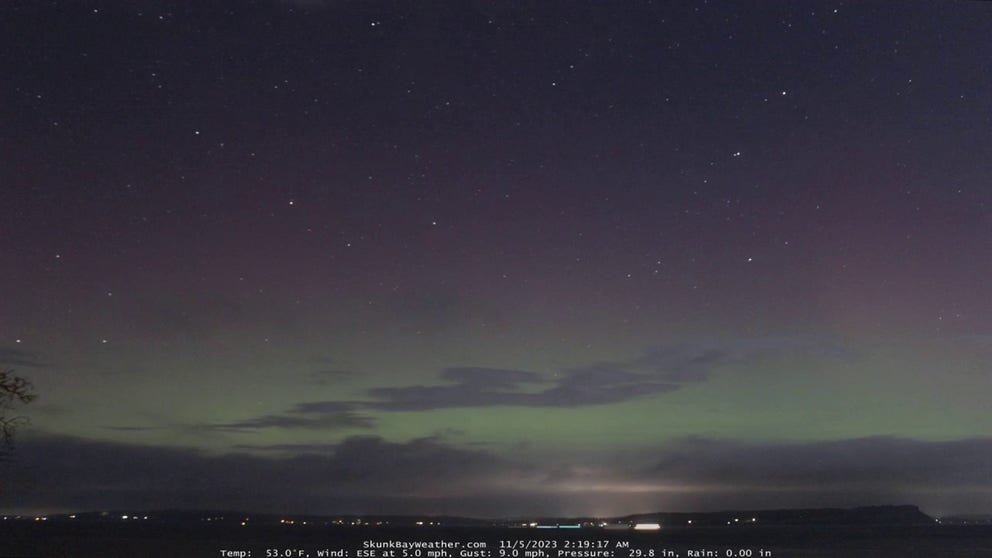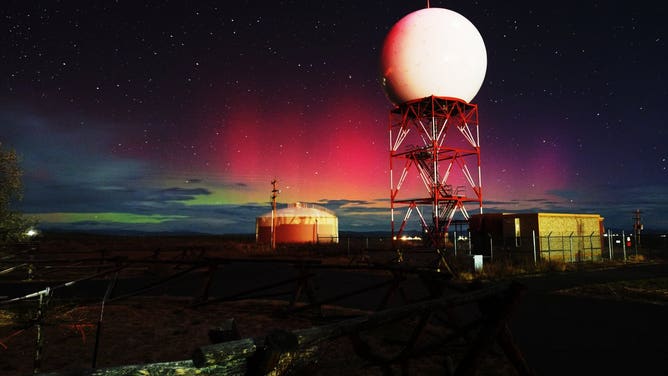Strong geomagnetic storm brings dazzling displays of the Northern Lights this week
The public does not need to be concerned by the geomagnetic storm, but it meant aurora lights were visible across the Northern U.S. from Washington to Maine.
Northern lights put on incredible display over northern US
A geomagnetic storm created an incredible view of the aurora lights in Wyoming, North Dakota, Maine and as far south as North Texas.
A series of geomagnetic disturbances from the Sun reached Earth's atmosphere in recent days giving some residents in the Northern Hemisphere a light show in the form of the Aurora Borealis over the weekend and the aurora lights are forecast to continue later this week.
NOAA’s Space Weather Prediction Center said solar storm influences from what are known as Coronal Mass Ejections (CMEs) and a Coronal Hole High-Speed Stream reached Earth on Sunday, with effects lasting through Monday morning.
NOAA's SWPC issued a Geomagnetic Storm Alert on Sunday warning of the potential interference with communication systems and spacecraft operations. The public does not need to be concerned by the geomagnetic storm, but it meant those as far south as Nebraska, Iowa and northern Illinois had the chance to see aurora lights early Monday morning.
The SWPC said strong G3 storm levels were observed Sunday and are likely to continue into Monday though the strongest levels will happen in the U.S. during daylight hours, thwarting the peak conditions for aurora sightings.
Strong solar storms can wreak havoc on communication systems
During the most significant geometric storms, widespread power outages are possible, and communication systems are subject to failure.
"Solar magnetic variability regulates the frequency and severity of space weather events and hazards, which can interfere with the electrical grid, degrade GPS signals, increase orbital drag on satellites, and pose radiation hazards to airline crews and astronauts," the SWPC said.
SEE THE OBJECTS HUMANS LEFT BEHIND ON THE MOON
A failure to anticipate the strength of a geomagnetic storm in 2022 was blamed for the loss of more than three dozen SpaceX satellites that became inoperable and burned up in Earth’s atmosphere.
Aurora lights put on show across northern US
Watch: Aurora lights dancing in Seattle sky
A timelapse video from Skunkbay Weather taken on Sunday morning shows the Northern Lights dancing above Seattle in connection with a geomagnetic storm watch.
The current storm has already been putting on a show since Sunday.
Aurora lights were spotted Sunday morning in Washington, Wyoming and Maine. Forecasters with the National Weather Service in Riverton, Wyoming, shared the photo below of the glowing amber sky taken on early Sunday.
The dancing lights were also seen on the outskirts of Seattle. Skunkbay Weather captured the green hues early Sunday in a timelapse video.
Overnight into Monday, green and pink Northern Lights were visible over Mt. Katahdin, Maine.
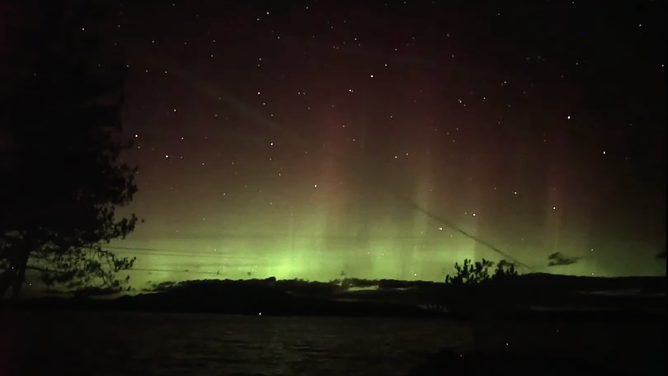
Aurora lights over Mt. Katahdin, Maine. (image credit: Neoc.com)
Forecasters with the NWS office in Spokane captured beautiful green auroras looking north late Sunday night.
Even places that normally see the Northern Lights close to the Arctic Circle are getting a stellar show this week. The solar storm is increasing activity in places like Alaska and Sweden.
The photo below from LightsOverLapland.com was taken at Abisko National Park in Sweden, just north of the Arctic Circle.
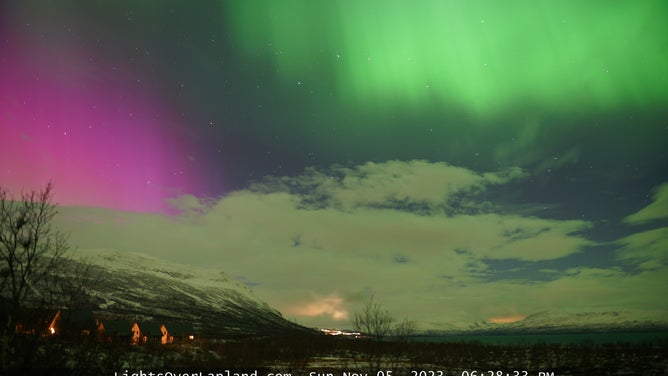
The Northern Lights seen above Abisko National Park in Sweden on Nov 6, 2023. (Image: LightsOverLapland.com)
Storm weakening but aurora still possible in farther northern latitudes this week.
Space experts admit determining the exact strength of the activity is challenging. But Sunday the Kp index reached a Level 7 out of 9 indicating a strong storm. The scale is used to characterize the magnitude of geomagnetic activity, and when values reach at least a 7, cities such as Seattle and Green Bay, Wisconsin, start to see significant chances of witnessing the Northern Lights if skies are clear and light pollution is low.
Later Monday is forecast to drop a Level 3 on the Kp Index scale, indicating weaker activity.
7 THINGS TO KNOW ABOUT THE NORTHERN LIGHTS
Still, with the ongoing geomagnetic storm, there is another chance after midnight on Tuesday to see faint aurora lights in the far northern U.S.

(FOX Weather)
Cloud cover can inhibit viewing, and large sections of the northern U.S. are forecast to be under a decent layer of clouds from Monday night into Tuesday morning, as is common during the fall and winter.
The University of Alaska Fairbanks aurora forecast shows another spike in Northern Lights activity possible on Thursday night.
Geomagnetic Storms likely to become more frequent
Geomagnetic storms could become more frequent over the next year as the sun begins to move into the solar maximum phase of its 11-year cycle.
A solar cycle is a sequence the sun’s magnetic field goes through every 11 years, where the field flips.
